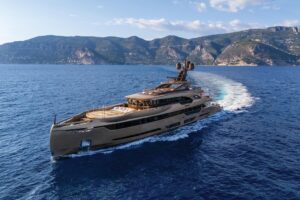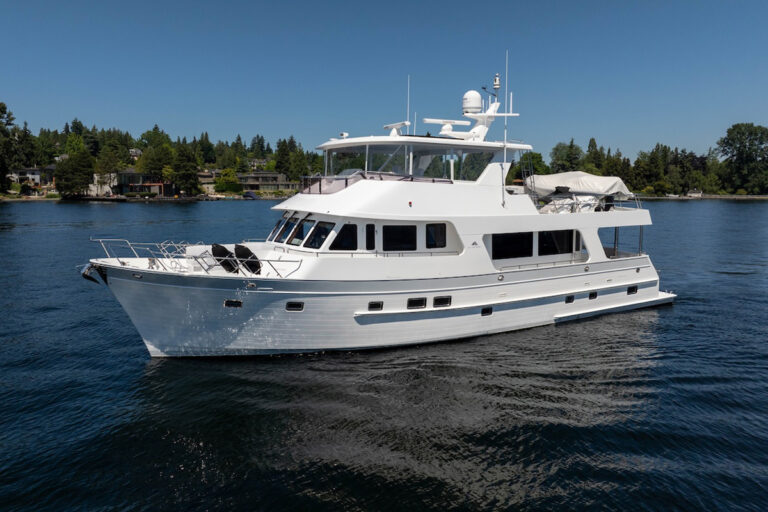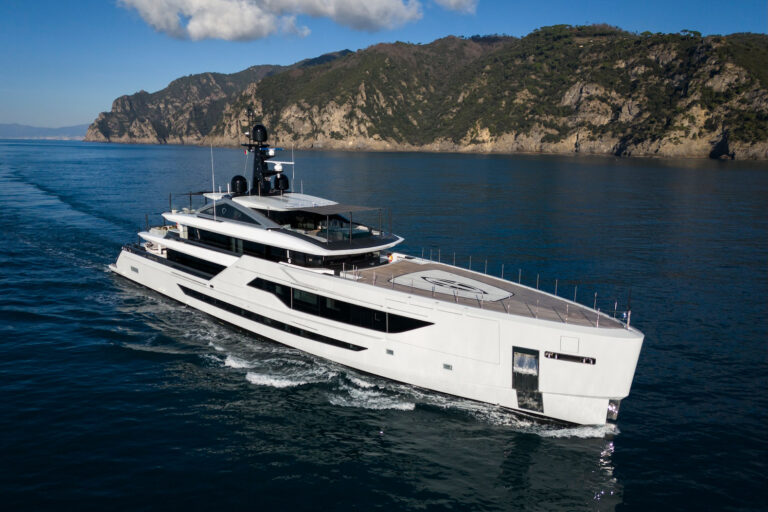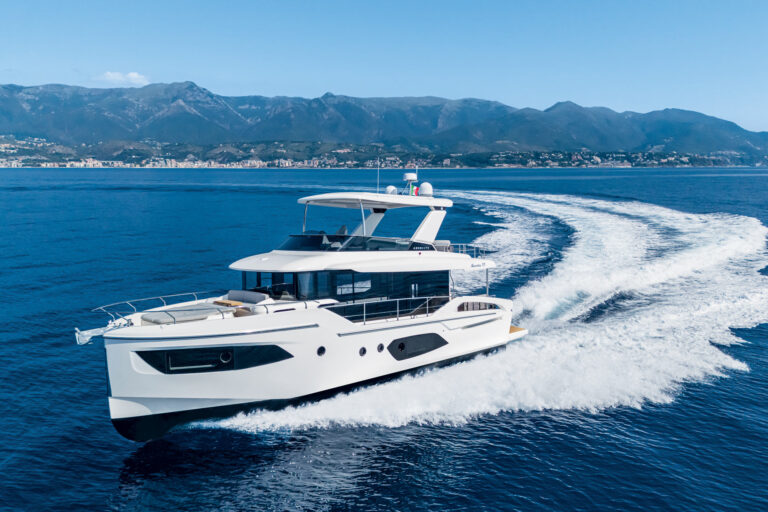The trades bellowed from the east, cascading down the steep hills of St. Thomas and straining the lines aboard Ocean’s Apart. Weighed down by sea bags and gear, I lurched along the decaying dock at the Yacht Haven Marina, taking breaks every few hundred yards. There was a hint of excitement as I caught sight of my old friend, who seemed displeased tied to the cement pier in this once flourishing marina and hotel. On this Saturday, the landscape could easily have been camouflaged in the Beirut skyline.
I removed my shoes and stepped on board. The simple comfort of her weathered teak decks under my bare feet erased all the stress of travel, deadlines and daily life. This 46-foot Grand Banks and I would have plenty of time to get reacquainted voyaging from the Virgin Islands to Ft. Lauderdale.
Three years earlier, I had met Ocean’s Apart in Hollywood, Florida, and helped deliver her to St. Thomas. A sailor since birth, I had covered most of the waters, but that was my first extensive offshore powerboat cruise. My good friend Tommy McCoy, who delivers charter boats to his St. Thomas-based charter company, helped me along with a crash course.
The journey showed me there is an alternative to slugging to windward on a sailboat, soaked to the bone with battered hands and salt-sore skin, sleeping in a muggy, hot cabin strapped in with lee cloths. We landed an abundance of fish, maintained a respectable 10 knots and stayed ahead of bad weather. Sleep came easily, our minds and bodies lulled by the yacht’s gentle motion and air-conditioned cabin. The washer and dryer prevented us from looking like boat bums, and the watermaker kept everyone, including the boat, fresh.
Since that trip, I have delivered similar boats between Florida and the Virgin Islands, in calm and extreme weather. Each time, I have been amazed at the near absence of mid-size powerboats cruising beyond the Bahamas toward the Caribbean. Cruising in southern latitudes on a well-equipped powerboat is tough to beat.
With that attitude in mind and my love of sail firmly planted in my pocket, I checked the systems aboard Ocean’s Apart and headed to the airport to pick up my crew members.
Tom is an accomplished and methodical sailor who teaches offshore sailing classes in Connecticut. His time aboard powerboats was limited. Steve has been running powerboats for almost 25 years and, after a successful career as a yacht broker, was looking forward to getting back on the water.
I looked forward to navigating this always available, but often overlooked, powerboat trip with them, serving my turn in the same role Tommy McCoy had served for me.
HEADING OUT
Undertaking this trip by power means a different checklist for provisioning and getting under way, whether you’re used to similar trips by sail or shorter trips by power.
I estimated our journey would take seven to 10 days and planned appropriate provisions, including an extra week for reserve. We walked to the Pueblo market across the street from the marina in the bustling downtown of Charlotte Amalie, and Tom shot me a curious look when I grabbed two shopping carts on our way into the store. More familiar with stacking stores in bilges and sock drawers, Tom quickly caught on to my blitzkrieg assault on each aisle, filling the carts until the wheels bent.
Meats. Vegetables. Soda. Canned goods. Heineken. Ice cream. Thanks to our two refrigerators and deep freeze, we could have provisioned for months. Tom debated buying fresh eggs instead of powdered Egg Beaters, which his sailor’s mind told him were better suited for a boat. I enjoy cooking and have issues with artificial substitutes, and knew we weren’t going to be heeled over throwing the refrigerator contents to the corner. Tom quickly warmed to the idea. (We lost one egg on the way to the boat, but throughout the trip enjoyed French toast, omelets and homemade dressings.)
After stowing our small convenience store, we secured our loose items, unpacked our bags, located the life preservers, checked the epirb and flares, reviewed our charts and re-checked all systems.
I had purchased enough oil for 21/2 changes. We checked the dual Racor fuel filters and changed them where necessary. (When preparing to cruise off the beaten track, it’s a good idea to buy a good supply of filters in case you pick up suspect diesel.) We topped off the coolant and checked the battery level, then reviewed the strainers and seacocks. Steve, among other things, is an ace mechanic. I soon stepped aside in the engineroom while he went through the space in detail.
On several occasions during the trip, we would be about 200 miles from land. Ocean’s Apart is not equipped with a liferaft, so I provisioned the RIB with water, food, a handheld GPS and VHF, flares, a first aid kit, warm clothing and some tools. The dinghy was secured upright on deck-mounted chocks, and I lashed a good-size blade on the stanchion in case we had to leave in a hurry.
The key on a trip of this type is being ready for things you have not encountered in your more familiar cruising grounds. We felt prepared as we settled into our berths late Saturday night.
Day One
Clearing customs Sunday was easier than expected, allowing us to cast off our lines by 9:30 a.m. The engines purred and wafted diesel in the early morning breeze while the burning sun heated the air to a comfortable 85 degrees. Steve and I were not concerned with the forecast for 20- to 25-knot winds and 8- to 10-foot seas. The ride would surely be uncomfortable, but not dangerous.
Tom was less comfortable with the forecast. He likely was recalling personal experience with Caribbean weather, and his concerns were confirmed as we turned the corner.
A 37-foot sailboat was bashing its way to windward with spray assaulting the dodger where the crew huddled. We motored by, blasting the best of J.J. Cale on the stereo, applying sunblock and watching the sailboat from our dry bridge.
Eyeing the uncomfortable souls ahead of us, Tom asked, “What’s our stability rating on this thing?”
I shrugged, then assured him we were safe. I had been in a similar boat the year before in 10- to 15-foot seas off the after quarter, and she was fine.
His piercing glance and subtle smirk showed him to be a nonbeliever.
The following seas pushed us forward at 12 knots, occasionally carrying our stern off the front of a wave. The 15-year-old, weak autopilot, combined with our square transom and undersize rudders, meant the autopilot had to be switched off and we had to hand-steer for a spell. Except for the generator failing, we had no other problems during the first day.
We motored past Puerto Rico. No bulkheads murmured, no decks creaked, no rigging clanged. The only noise was the purr of the big Cats and the blue water pushing away from the bow stem.
Late in the afternoon, Tom popped his head up from a chart. To nobody in particular, he whispered, “Wow, this thing is like a tank.”
Just before sundown, with San Juan to our beam, we turned toward the northern side of Silver Banks. Our next stop would be Provo in the Turks and Caicos islands.
Day Two
I arrived on the bridge at 4 a.m. to relieve Steve of the watch. These early morning hours are my favorite time on the water. There is still a slight chill in the air, and anticipating sunlight brings the same feeling I had as a 4-year-old waiting for Santa Claus. Gradually, the sky becomes lighter. The tops of waves, at night a distant, gurgling groan creeping up behind you, suddenly have faces. The assortment of flying fish that found your craft mid-flight become visible, lying lifeless on the deck. Over the eastern horizon, a line of crisp light begins to rise, bringing on a new day and giving a burst of energy to a tired crew.
“Boy, I need to do this more often!” Steve said.
By morning, we began to settle into a routine, releasing the anxiety of the departure and forgetting the burdens of shore-side life. Our world on Ocean’s Apart was simple: shower, clean the interior, steer, cook, eat, sleep, navigate and check the engines. There were no sails to change or reef, no winches to grind.
The conversation during our lunch of a salad and chicken breasts with roasted red peppers revealed a few more differences between powerboaters and sailors.
“This is like driving a bus,” Tom said. “On a sailboat, four hours goes by a lot quicker. I guess there’s more to do.”
He was speaking more of the boat’s solid, easy handling characteristics than the simple routine we’d adopted, but his words were misinterpreted.
“There’s plenty to keep you busy,” Steve said, somewhat in wonder. “We have toilets that need cleaning, a genset that needs to be fixed, bilges to clean, engines that need to be checked.”
Left unchecked, the decades-old debate of sail vs. power could have erupted into an uncomfortable dialogue, though not nearly as uncomfortable as the discussions Tom and Steve shared about politics. (Imagine Jesse Helms spending seven days on a boat with Hillary Clinton.)
Throughout the trip, Steve and I attempted to convince Tom that powerboats can also cruise long distances-sometimes more comfortably than sailboats. He questioned our fuel burn calculations for the first 48 hours, so we brought out Cat’s own fuel curve. He remained fixated on the reliability of diesels and our predicament of not having sails as a backup.
He brought up several valid points, but refused to agree that for a 1,200-mile island hop, a well-founded powerboat affords more stowage, comfort and amenities than a similar-size sailboat.
And he remained unconvinced that the commercial fishing and merchant marine fleets plying the world’s oceans were good examples of reliable power craft.
Day Three
We approached Provo, bumping the engines up to 2400 rpm to clean out the injectors. We blazed toward the entrance and looked for the hard-to-find sticks marking the break in the reef. On a rough day, the channel is easier to spot thanks to the breakers on both sides, although the wind will often blow the markers horizontal.
We arrived exactly at our waypoint and proceeded toward the mark. Our fatigue showed during a long discussion about the entrance, and we called the dockmaster at Turtle Cove.
She offered a guide, so we checked our egos at the chart table and took the helping hand.
A new landfall always rejuvenates the soul, for at least two reasons: the sense of satisfaction in having gotten the yacht there, and the excitement of being in a new place. Customs officers were delayed looking for the correct paperwork but could not have been more accommodating. They allowed us to go for lunch at the marina. The marina called on the VHF to inquire about their estimated time of arrival.
“Anytime soon,” came the reply.
So be it.
Day Four
After breakfast, we hiked to a patch of white sand off one of Provo’s many spectacular reefs. An array of fish and reef life flocked in the water, putting on a show for us before we returned to Ocean’s Apart. Our plan was to leave “sometime” that morning. Steve and I soaked in the beauty of the reef and the deserted beach, but Tom grew more and more preoccupied with our departure time. His sailor’s habits told him something about our need to get going if we were going to make landfall during light. This obsession evaporated after he realized we could adjust our speed between 8 and 17 knots to ensure a safe landfall, provided we had good weather.
We departed Provo around 11 a.m. and headed toward the Exuma chain in the Bahamas. I always look forward to getting back to sea and maintaining perpetual motion. The senses are heightened, and the simple routine breeds pure contentment.
Steve seconded the notion that night. “I don’t even know what day it is,” he bellowed, “and I don’t care.”
We cruised north of Mayaguana and Long Island, cranking the throttles back to 1500 rpm and maintaining about 9.5 knots while heading toward Staniel Cay. The rumbling of the engines was soothing. The sound of the water parting at the bow provided the necessary harmony. The phosphorus danced in all directions like a gang of laughing children unwilling to let you in on their game.
Being onboard lets the mind grow more acute, more aware of the surroundings. I wondered how many perfectly cast golden sunsets I had missed while battling rush-hour traffic.
Days Five And Six
The sun was no longer warming our little ship. Skies turned black as a front moved over the Bahamas. We increased our speed after checking fuel consumption, then navigated Big Rock Cut in a squall and tied up at the Staniel Cay Yacht Club.
Around sunset, a flock of dinghies swarmed in from the anchorages around Staniel Cay for cocktails and dinner at the club. We joined the guests, primarily sailors, at the bar and swapped sea stories. The conversation seemed to be dominated by weather, instead of what a perfect place we were in and how fortunate we were to be there.
“I have to be in Georgetown by the 16th and hope the front doesn’t ruin my plans,” said an owner of a 40-foot sailboat. He had 16 days to cover 200 miles, with no plans to stop in between. He was not unlike the other sailors in the group, for whom a general theme of anxiety dominated the conversation about their journeys. Many of them ignored the destination entirely.
We, on the other hand, delayed our departure a day to enjoy Staniel Cay. After diving in the cave at Thunderball and exploring the island, we made plans to return.
The forecast called for north winds and 9-foot seas in the Gulf Stream. Tom’s confidence in Ocean’s Apart‘s seaworthiness was improved, but not total.
“It will be uncomfortable,” he told a sailor docked nearby, “but should be no problem.”
Day Seven
We departed around 10 a.m. and made our way across the shallow Exuma Bank, heading for the northern tip of the Tongue of the Ocean. As the sun set, the lights of Nassau cast a warm glow over the otherwise dark sea. Several hours later, we passed north of North Light and headed across the Bahamas Banks in the dark, something most yachtsmen, no matter their stripes, should try to avoid.
After seven days on board, we became intimate with the boat’s motion and characteristics. The plate sliding across the galley counter was met automatically by the hand, without the body breaking stride. The once cumbersome climb to the flying bridge became a fluid, singular motion.
Nine-foot seas never materialized. I awoke to take my last watch and found bright skies and calm seas. We entered the last 50 miles of our journey to Ft. Lauderdale.
We arrived at the dock of Hal Jones and Company, the listing broker for Ocean’s Apart, eight days after boarding in St. Thomas. The early days of looking for switches and handholds, of learning the boat’s quirks, were long gone. There was a tinge of sadness at the thought of putting the boat away. Ocean’s Apart had become home.
Steve and Tom packed up and headed to their homes in Tampa and Palm Beach. Steve has already asked when we can return to sea again, hoping to share part of the powerboat voyage with his fiancée.
Tom said he enjoyed the onboard comfort and planned to begin a search for a larger, more comfortable sailboat. He left understanding the ease with which powerboats can cruise, but I don’t expect he will trade in his sailboat for a powerboat.
In fact, I hope he doesn’t.
I still need someone to go sailing with.
It’s no wonder why.








